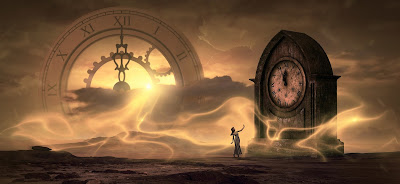While I was working on the fifth book in the RHUNA series, namely Rhuna, The Snow Dreamer, which is set in Tibet, I was planning ahead and paving the way for Rhuna to journey northwards towards China. Naturally, she would take the ancient Silk Road, and I browsed the internet for interesting and unusual places along this famous trade route which might provide further ideas or inspiration for the next books in the series.
 |
| https://www.amazon.com/gp/product/B07ZLM6RF3 |
“Ghosts
live here. That's what the Chinese say. They claim this place, a walled
fortress abandoned in the 14th century and called Khara Khoto—Black City—is
inhabited by demons and spirits.”
https://www.nationalgeographic.com/science/earth/surface-of-the-earth/alashan-plateau-article/
Magic and supernatural events are
frequently mentioned in describing the city’s history and ultimate demise as
well. Imagine my surprise when I read
about the ruler of the Black City using Black Magic in “Men
and Gods in Mongolia” by Henning Haslund, a Danish anthropologist and
travel writer who explored Mongolia in the 1920s.
“And then I began to hear the
legends of Khara-Khoto, “The Black and Dead city”, which once was ruled by
Khara-Bator Janjyn…who bore the name of Khara because he could talk “Khara
ugge” (black words = magic formulas)”
It was exciting to find that real-life historical texts mirrored the villain in my Rhuna series whom I had named ‘the Dark Master’ because he wore black and practiced black magic! For example, in one text, the ruler is called “the Black Hero”, and when his city was about to be defeated, he killed his family and tried to escape using black magic.
 |
There are several different
versions of the Black City’s demise, but most are similar in describing the
attack on the city by first re-directing the course of its river and thereby
cutting off the city’s water supply.
Some records describe the Chinese Emperor destroying Black City in this
way:
“The (Chinese) Emperor himself threw a magic stone into the river, which gave water to the besieged, and the stone, falling between the town and the sources of the river, caused the water to leave its ancient bed and break a new course for itself far to the westward of the town.
(from “Men and Gods in Mongolia” by Henning
Haslund)
https://www.amazon.com/dp/1939149436
When the site of Khara-Khoto was excavated and documented by archaeologists early last century, many scrolls in an unknown language were discovered.
“But parts of the documents were never deciphered, because they were written in a language unknown to the researchers. According to one of the versions, ancient priests had encrypted magic texts in the scrolls. And according to others, those were probably the only documents serving as proof of the ancient civilization that built the city of Khara-Khoto.”
http://ancients-bg.com/curse-of-the-dead-city-of-khara-khoto/
It is quite surprising that this ancient city has so many legends and stories involving magic, the supernatural and continual hauntings down to this present day. You could almost believe that the Dark Master really did exist and caused such supernatural chaos in the Black City!
http://www.silkroadtourcn.com/attractions/Khara-Khoto.html


















































